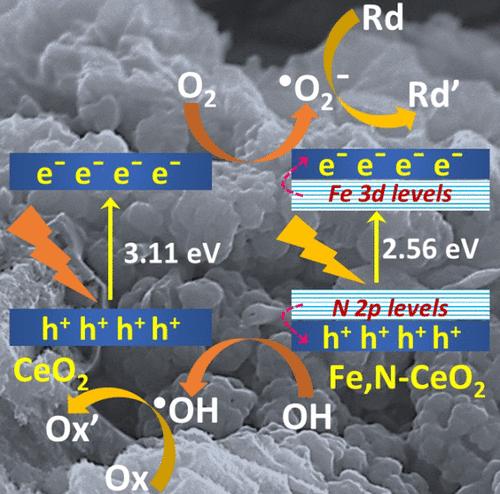Fe, N双掺杂氧化铈光催化剂在日光下同时降解染料-重金属混合污染物
IF 3.9
3区 工程技术
Q2 ENGINEERING, CHEMICAL
引用次数: 0
摘要
本研究采用溶胶-凝胶法研究了不同浓度的铁(Fe)和氮(N)双掺杂对氧化铈/铈(CeO2)的影响,分别为5%、10%和15% mol %。结构、化学环境和氧化态分析表明,双掺杂有效地影响了铈离子的晶体结构、Ce3+↔Ce4+的可切换氧化态以及掺杂剂介导的对缺陷结构造成的电荷不平衡的补偿。根据这些观测结果,通过光学分析证实了延长波长的光学吸光度增强和电荷复合减少等变化。结果表明,双掺杂氧化铈在日光照射下对罗丹明B和铬VI重金属离子的单独和同时降解和还原能力增强。在2.5 h内,裸体系降解了约50%的污染物,而优化后的双掺杂氧化铈(10 mol %)在单独和混合条件下降解了近100%的污染物。这种观察到的增强是由于铈的传导带和价带分别向更多的负电位和正电位移动,使这些电位更适合于有效的同时光氧化还原反应。此外,掺杂体系的循环效率在所有5个循环中保持一致,显示出经后期表征证实的稳定性,使其具有扩大应用的前景。本文章由计算机程序翻译,如有差异,请以英文原文为准。

Fe, N Dual-Doped Cerium Oxide Photocatalyst Manifesting the Simultaneous Degradation of Dye–Heavy Metal Mixed Pollutants under Sunlight
This study explored the effect of dual doping with iron (Fe) and nitrogen (N) into cerium oxide/ceria (CeO2) at different concentrations, specifically 5, 10, and 15 mol %, using a sol–gel method. Structural, chemical environment, and oxidation state analyses revealed that dual doping effectively influenced the crystal structure, switchable oxidation states of cerium ions (Ce3+ ↔ Ce4+), and dopant-mediated compensation of the charge imbalance created by defect structures. In line with these observations, changes such as enhanced optical absorbance in extended wavelengths and decreased charge recombination were confirmed through optical analyses. As a result, the dual-doped ceria demonstrated enhanced individual and simultaneous degradation and reduction of rhodamine B and chromium VI heavy metal ions under sunlight irradiation. Over 2.5 h, the bare system degraded around 50% of the pollutants, while the optimized dual-doped ceria (10 mol %) degraded nearly 100% of the pollutants under both sole and mixed conditions. This observed enhancement was attributed to the shifting of the conduction and valence bands of ceria to more negative and positive potentials, respectively, positioning these potentials more suitably for effective simultaneous photoredox reactions. Furthermore, the cyclic efficiency of the doped system remained consistent across all 5 cycles, demonstrating stability confirmed by post-characterization, making it promising for scale-up applications.
求助全文
通过发布文献求助,成功后即可免费获取论文全文。
去求助
来源期刊

Industrial & Engineering Chemistry Research
工程技术-工程:化工
CiteScore
7.40
自引率
7.10%
发文量
1467
审稿时长
2.8 months
期刊介绍:
ndustrial & Engineering Chemistry, with variations in title and format, has been published since 1909 by the American Chemical Society. Industrial & Engineering Chemistry Research is a weekly publication that reports industrial and academic research in the broad fields of applied chemistry and chemical engineering with special focus on fundamentals, processes, and products.
 求助内容:
求助内容: 应助结果提醒方式:
应助结果提醒方式:


